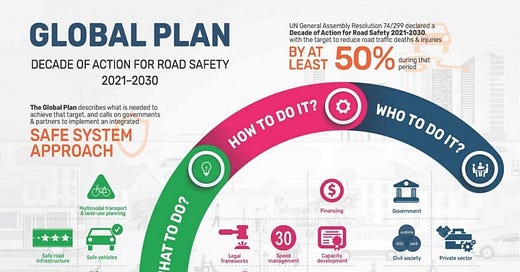Road safety: a safe system to ride more
A bicycle mobility strategy should consider road safety as a key pillar
Many people do not use the bicycle as a means of transport due to road safety issues, real or perceived. Hence, a bicycle mobility strategy should consider this matter as a key pillar. Though there are very specific considerations for cycling mobility, road safety must be integrated from a comprehensive perspective for urban commuters and not in isolation for each mode of transport.
1.3 million deaths and 50 million serious injuries from traffic crash yearly constitute, which constitutes a global social and economic tragedy. About 90% of these deaths occur in low- and middle-income countries, representing social costs equivalent to an average of 2.2% of GDP. In Latin America, the rate of traffic deaths per 100,000 inhabitants is close to 20%, from 14.75 to 17.68 between 2000 and 2010, and approximately 30% of these deaths were people who walked or traveled by bicycle.
The United Nations Organization's Decade of Road Safety Action is the most significant global effort to reduce traffic deaths. After the first edition ( 2011-2020 ) failed in its goal of halving worldwide traffic deaths, the General Assembly of the UN proclaimed the second decade for 2021-2030 with the same objective. It urges countries to take action guided by the five pillars of the safe systems approach, adapting its regulatory and legislative framework.


Vision Zero in Sweden and Sustainable Road Safety are examples of successful policies that follow the “Safe Systems” approach, which has resulted in a 50% reduction in the number of fatal crashes between 1994 and 2015, making both countries two of the safest in the world. The safe system approach moves away from more traditional efforts like isolated road education and behavior campaigns. It assumes that the user can make mistakes without this resulting in serious accidents. In the safe system, road design absorbs those risks to which the traditional road system is not very tolerant, thus avoiding serious or fatal consequences, especially for the most vulnerable users of the road.
For example, the Mexico City Transport Department (Secretaría de Movilidad) coordinated an inter-institutional effort in 2016 to create a Comprehensive Road Safety Program (PISVI) based on the five pillars of the safe system. The new version (in Spanish) of the PISVI was reorganized into 3 axes (institutionalize, build, educate) and includes the goal of reducing road deaths by 30% by 2024. Bogotá adopted a Vision Zero policy with the objective of eliminating all road deaths by 2038. The Transport Department of the Colombian capital has opted for a communication effort to transmit progress in road safety.
Safety in numbers
The concept of safety in numbers establishes that the more people walk or use the bicycle, the greater their safety. That is, the levels of fatal incidents for these transportation modes are inversely proportional to the percentage of trips made in them. This can be explained (in part) by an adjustment in the behavior of motorists when perceiving more people walking or cycling.
Considering that the safety for people in active mobility modes in a city increases as its use rises, national, subnational, and local governments should focus their public policies and resources in the transport sector on increasing bicycle use. Coercive measures, such as regulations that establish the use of a bicycle helmet in the streets of the city as mandatory, end up having a deterrent effect and therefore, make the conditions for using the bicycle more unsafe. Measures such as fines or confiscating bicycles end up disproportionately affecting bicycle users with fewer financial resources. Therefore, such measures should be avoided, efforts must be focused on making safer streets by reducing risks at the source and helping to integrate the bicycle into everyday life.

The planning and the design of quality cycling-infrastructure are essential elements to encourage bicycle use and, therefore, increase road safety for users. However, the implementation of this infrastructure should not be isolated but part of the integrated framework of cycle-inclusion in all aspects of transportation planning.

See more information at:
Safety in numbers: more walkers and bicyclists, safer walking and bicycling.
Road Safety in Latin America and the Caribbean: from theory to action. Massive Online Course of the Inter-American Development Bank (In Spanish).






